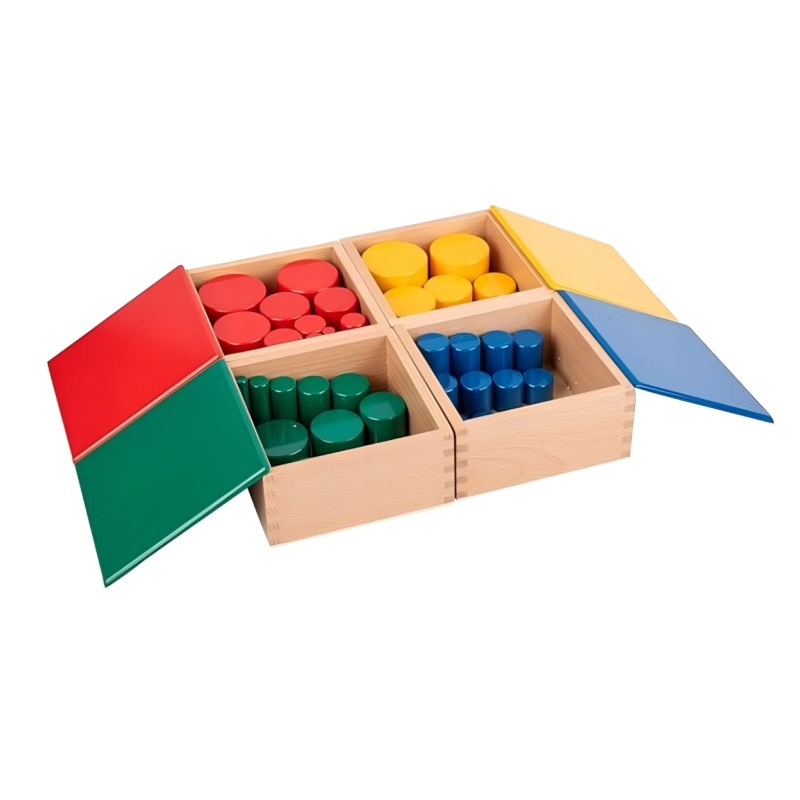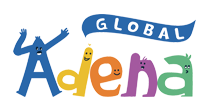
Knobless Cylinders (Set of 4) A030
A030 Knobless Cylinders (Set of 4)
Materials:
Set 1 (Yellow): Cylinders varying in both height and diameter.
Set 2 (Green): Cylinders varying in both height and diameter.
Set 3 (Red): Cylinders varying in diameter only.
Set 4 (Blue): Cylinders varying in height only.
Preparation:
This is an individual activity, suitable for tabletop or floor work using appropriate mats.
(Observation of the child's complete work cycle is essential.)
Presentation:
The Directress demonstrates how to carry the box of cylinders to the work area using both hands.
The Directress sits beside the child and places one box of cylinders in front of them. She demonstrates how to remove the cylinders using a three-finger grip on the top of each cylinder.
The Directress demonstrates:
Grading: Arranging the cylinders in order of size (e.g., largest to smallest). (Exercise 1)
Tower Building: Constructing a tower with the cylinders, starting with the largest at the bottom. (Exercise 2)
Exploration: Combining two or three sets of cylinders to discover relationships and differences in dimensions. (Exercise 3)
The Directress may use the Three-Period Lesson to introduce the vocabulary "big/small" and "short/tall."
The cylinders are replaced in the box, largest to smallest, and the box is returned to the shelf.
Points of Interest:
The Knobless Cylinders provide a more abstract experience compared to the Knobbed Cylinders.
Prior experience with Knobbed Cylinders, the Pink Tower, Broad Stair, and Long Rods aids in the child's success.
Encourage the child to grade various objects of different sizes (e.g., candle holders, buckets, paper clips, chairs).
Purpose:
Develop visual discrimination of size and dimension.
Refine coordination and fine motor control.
Provide concrete experiences with seriation and comparison.
Introduce mathematical vocabulary.
Indirectly prepare for reading and writing through visual discrimination.
Strengthen the pincer grip.
Variations:
Exercise 1: Grading
The child grades each set of cylinders individually, arranging them in a line from largest to smallest.
Exercise 2: Tower Building
The child builds a tower with each set of cylinders, starting with the largest at the bottom.
Exercise 3: Combining Sets
Use two sets (e.g., Set 1 and Set 2).
Build a tower alternating cylinders from each set.
Introduce Set 3 when the child is competent.
Use two sets (e.g., Set 1 and Set 2).
Grade Set 1.
Grade Set 2 and place them on top of the graded Set 1.
Introduce Set 3 when the child is competent.
The child combines two or three sets of cylinders to explore relationships in dimensions.
Stage 1: Grading with Multiple Sets
Stage 2: Tower Building with Multiple Sets
Extension: Combining Knobbed and Knobless Cylinders
Grade the Knobless Cylinders.
Invite the child to place each Knobbed Cylinder on top of or beside its corresponding Knobless Cylinder to demonstrate matching dimensions.
Note: Set 4 is primarily used for comparison and is not graded or built with the other sets due to its differing diameter.
 Knobless Cylinders (Set of 4) A030
Knobless Cylinders (Set of 4) A030
